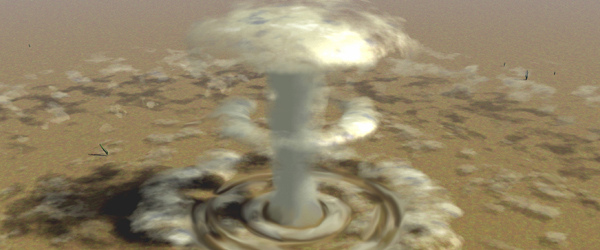A 1969 report prepared for the Office of Civil Defense details a proposal that was never adopted for a program called CHAT: Crisis Home Alerting Technique. In recognition of the fact that this military acronym wouldn’t be of much use with the public, a more descriptive name was proposed for dealings with the public: Emergency Broadcast System Sleep Alert.
The Emergency Broadcast System was designed to alert the public through normal broadcast stations of enemy attack. Sirens were available in many areas, but large portions of the population would be unable to hear them, especially at night. And at night, most Americans would be asleep, and not listening to radio or television. A nighttime attack would catch Americans by surprise, unless they were sleeping in shifts to listen to the news.
In a “bolt out of the blue” attack, the problem of nighttime alerts remained problematic. But during periods of strategic crisis, such as the Cuban Missile Crisis, CHAT or “Sleep Alert” provided an answer. During such a crisis, Americans could get their sleep, but also be able to receive warning. Upon determining that a crisis existed which might require warning the population, the President would activate the system, and the public would be notified to tune to participating stations in their area. The President would then make the following announcement, probably at 11:00 PM Eastern Time:
In a moment my voice will begin to fade; merely turn your volume up until you can hear me again. This is part of a system which will permit you to receive later emergency information. Please leave your receivers on constantly; when you wish to sleep, turn the volume down to a comfortable level, and I will be able to reach you my means of your radios and televisions.
The stations would then reduce their modulation to 10-20%. VHF TV stations would reduce the audio to zero. Viewers tuning in after 11:00 would know that they were tuned in, because they would see a message on the screen explaining that the station was operating in the sleep-alert mode. In addition, the detent tuning of VHF television receivers would ensure that the viewer was properly tuned in.
AM radio stations presented a problem, because listeners tuning in after 11:00 would need to know that their radio was tuned in to the proper station. Therefore, it was decided that “subdued materials” could be broadcast. The report noted that “the more exciting up-tempo kinds of music or the strident, demanding voice delivery techniques employed at many rock and roll stations” should be avoided. Instead, the program would be soft music or perhaps a clock ticking, with occasional station identification by “an announcer speaking softly but with calm authority” with the following message:
You are listening to the Emergency Broadcast System Sleep Alert. Stay tuned for a possible emergency warning from the United States Government. Adjust your radio volume to a level at which you can sleep. This station will resume broadcasting more loudly if warning is necessary. See your newspaper for more information.
Station personnel would then monitor the AP and UPI wires for warning messages. Stations without wire service would monitor Emergency Broadcast System primary stations. In the event of that fateful message, the station would turn up the volume to normal modulation, meaning that all of the listeners would confront a radio playing at full blast, which would presumably be enough to wake them. The station would then transmit a loud alert signal, followed by the following message:
Attack–Attack. The United States is Under Nuclear Attack. I repeat–the United States is under nuclear attack. Take shelter. Take shelter immediately. You are in danger–you can save your life if you take shelter immediately. This is the emergency broadcast system.
Assuming that there was no attack during the night, the station would gradually increase its modulation at 7:00 AM, and resume normal programming. CHAT was viewed as an interim measure, and had the advantage of not requiring any new equipment either on the part of broadcasters or the public. The plan was to replace it eventually with a more reliable system. But as a stopgap, it had the advantage of being able to be adopted readily. It was, however, never adopted.
It was at least a decade before the first 24-hour warning system came into effect, in the form of alerts broadcast on NOAA weather radio in the mid-1970’s. However, it was always subject to question how well NOAA weather radio was integrated into the national warning system. However, NOAA now makes clear that it will broadcast Presidential alerts during a national emergency, and it appears to be well integrated into the National Warning System. Modern NOAA weather receivers, such as the one shown here, take advantage of digital encoding (SAME), which will limit the number of false alarms for weather events in surrounding areas.
Click Here For Today’s Ripley’s Believe It Or Not Cartoon
![]()


